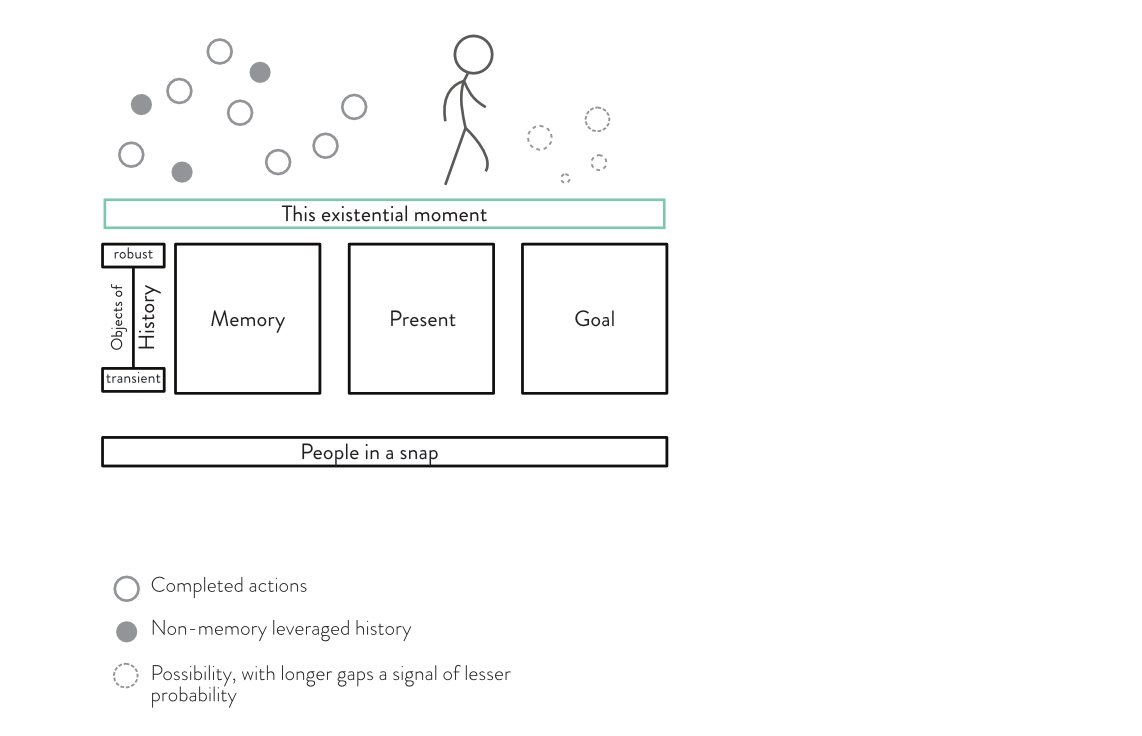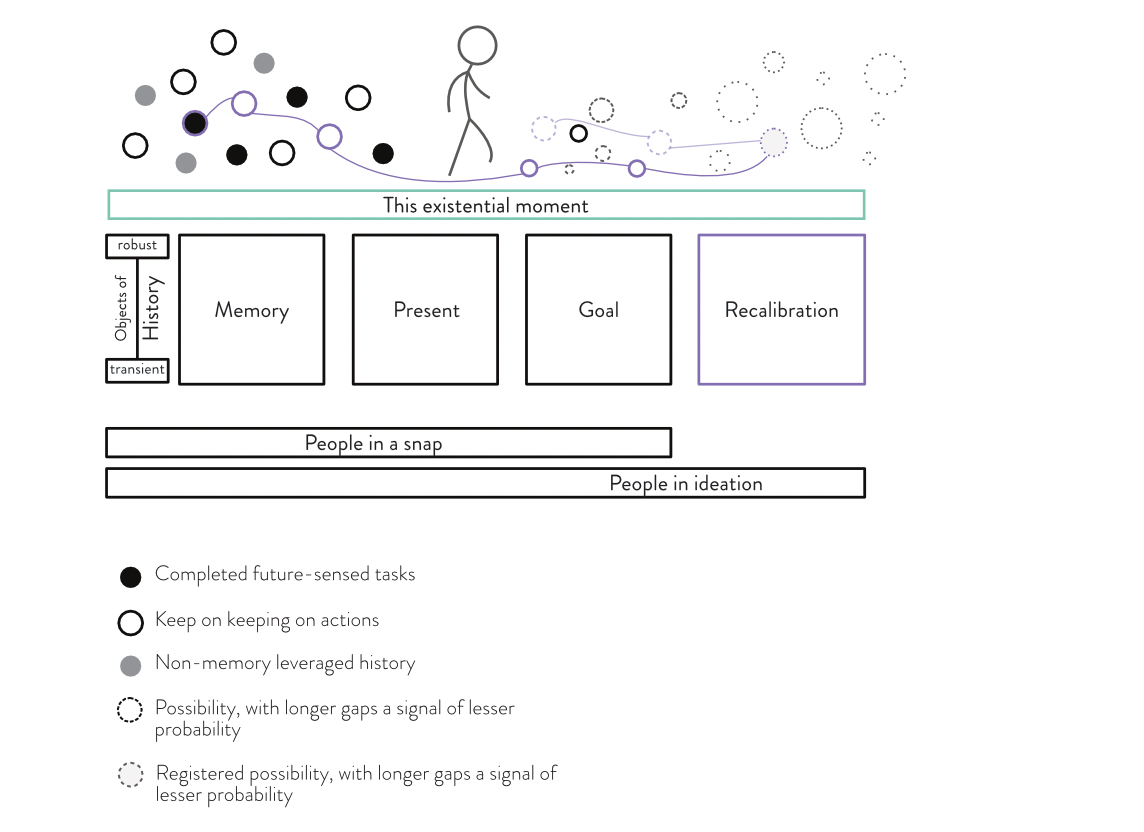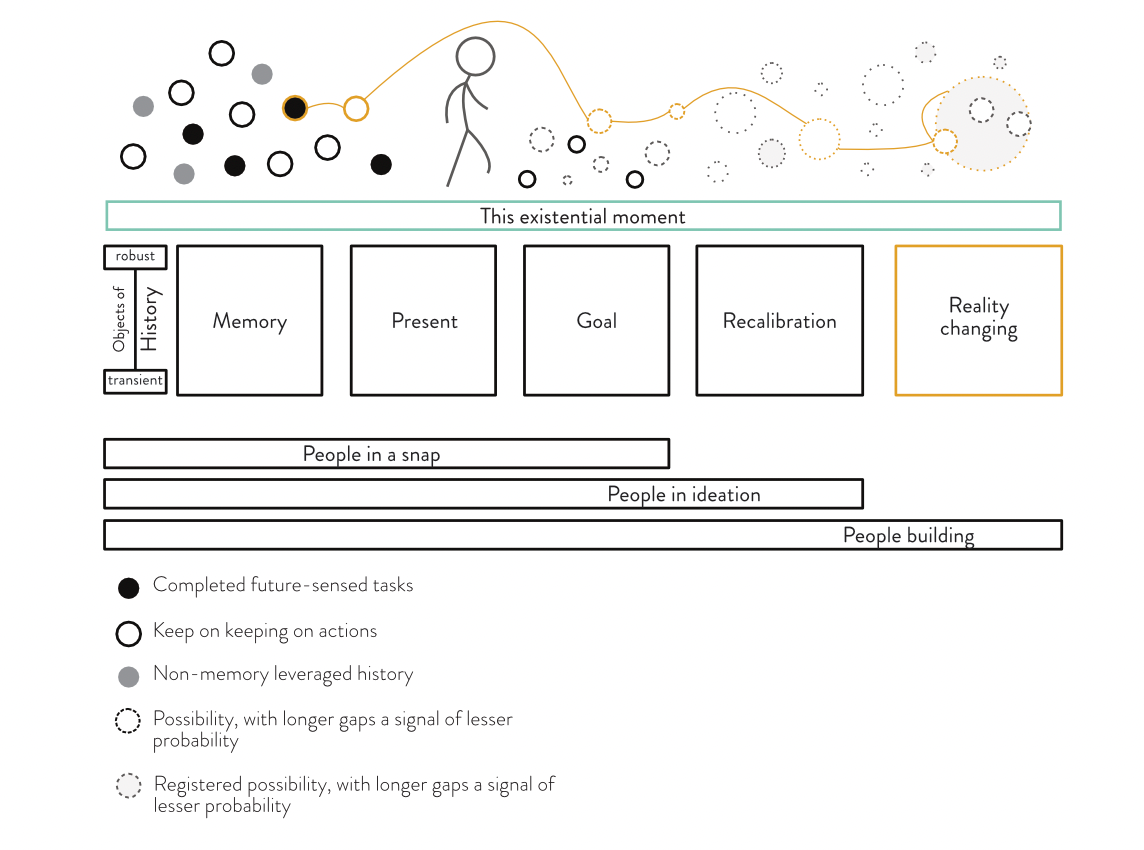 Move Frontmatter
Move Frontmatter
Open Frontmatter
© 2025, Angela Madsen
All rights reserved.
For Violet.
This book was written by a human mind with no AI assistance at any point in the process.
All confabulation is my own. All research gaps are my own. All interpretive thinking is my own. Annotations are the best I could manage with the timescapes involved, and will be continued to be worked for a while.
Three Buckminster Fuller structures are used in the Systems flow page; Manoogian & Benson's Cognitive Bias Codex is used on the Cognitive bias page; otherwise all images are created myself using either Affinity Design or sketching in Concept. This book has been through multiple versions, multiple software, and multiple structures through the five years I worked on articulating it. Tools have included Ulysses, Powerpoint, and Affinity Publisher.
Frontmatter
132 words
 Move People have a complex relationship with time
Move People have a complex relationship with time
Open People have a complex relationship with time
People have a complex relationship with time
This moment is rarely only this moment

A stick figure walking a horizon of 'this existential moment', which is overlayed on three boxes: memory, present, and goal. Nodes are behind the figure: completed actions. Nodes with dashed outlines are in front of the figure: possibilities. Underlaying it all: people in a snap.
As we move in this moment — even if it’s as ‘simple’ and ‘easy’ as taking a step, grasping an object, or saying a simple word — we are leveraging a mix of memory (past/orientation), environment (present/findability), and goal (future/navigation).
- **Taking a step: **remembering the mechanics and physical interplay, noting the rough surface here, understanding that the
People have a complex relationship with time
743 words
 Move Non-memory history: tools
Move Non-memory history: tools
Open Non-memory history: tools
Non-memory history: tools
People leveraging objects from outside the snap

Building on the previous diagram. A vertical spectrum node (with rectangles instead of circles) is to the left of memory, labels "objects of history". The top node is "robust", and the bottom node is "transient". Gray-filled nodes have been added behind the figure, which represent non-memory leveraged history.
We don’t have to dig that far into our histories to find when the only information we have are things left by those who came before: paths (which could also be non-human fauna), buildings, furniture, pots, clothing. As time continued it’s trudge forward, we added writing: our first information technology.
These are all tools. Tool are embedded with implici
Non-memory history: tools
737 words
 Move Managing our cognitive load
Move Managing our cognitive load
Open Managing our cognitive load
Managing our cognitive load
Keep on keeping on

Buidling on the previous diagram. Black-filled nodes have been added behind the figure, representing completed future-sensed tasks. One of those have been linked with a blue line to a series of black-outlined "keep on keeping on" nodes that reaches into the future.
When we figure out something that works, we keep it and play it over and over again – process, behavior, reaction, a good tool, anything that seems to get the results we want. Many of us don’t even reconsider the results.
We keep on keeping on. Do it often enough, and it becomes habit. Do it long enough, and it can become a stability point — something that, if touched and attempted (or actually!) moved by another, can cause an u
Managing our cognitive load
487 words
 Move Ideation
Move Ideation
Open Ideation
Ideation
People outside the snap

Building on the previous diagram. An extra box labeled "recalibration" and outlined in purple has been added to the right of "goal". The blue line has shifted to purple, and an additional trail starting in the immediate forward motion has been added. The node at the end of the connective lines has been shifted to gray-filled with a dashed outline, representing registered possibility. Another substrate has been added underneath "people in a snap", widened to include recalibration and labeled "people in ideation".
We play in the future all the time
Part of living in the now is that things continue to happen around us. Putin goes to war, ten ads try to take your mental space, someone falls down, someone ge
Ideation
417 words
 Move Building towards the future
Move Building towards the future
Open Building towards the future
Building towards the future
People outside the snap

Building on the previous diagram. Recalibration outline becomes black, and the recalibration line has disappeared. A box has been added to the right of recalibration, labeled "reality changing" and outlined in yellow. A yellow throughline, starting from a different inception, completed future-sense node and skipping through to a large registered possibility, has been traced. Another substrate has been added, scoping from objects of history to reality changing, labeled 'people building'.
We are in the constant and irrevocable process of stepping into the future, and we are always making bets on it and building towards it.
Anything we build is intended to shift something in the future.
Building towards the future
508 words
 Move The ouruborus of perception
Move The ouruborus of perception
Open The ouruborus of perception
The ouruborus of perception
Sense making is filtered through a perceiving mind
This process impacts all understanding.
People are individually complex — we are beings of networked, stratified, and variable processing. That processing affects the data we see, the filters we apply, the patterns and processes we develop, and the outcomes of our cogitation.
When we are moving through the world, our reference point is in multiple dimensions: the physical environment, our physical and emotional state, and time are the most prevalent. To get to from point A to point B, you have to navigate the physical interchanges. To navigate those points, you are experiencing time — which, depending on the context and the points in question, could shift the points as you are moving between them. And during all this, you could be focused and attentive, you could be distracted, you could be daydreaming about a potential happening, or crying over something that already happened. These are aspects of our environm
The ouruborus of perception
620 words
 Move We function into the future every day
Move We function into the future every day
Open We function into the future every day
We function into the future every day
Our relationship with time
Think about any person attending to their work. Assume this entailed, at least this one day, a commute. Maybe it was a standard commute, maybe they had a meeting in New York and they live in LA.
They got to work, probably on time. They ate at some point in the past few days (probably even this morning) so they aren’t distracted from the problem solving of their work. They already have plans in play about what they need to pick up on the way home, what chores have to be done sooner than later, and the various bits that they know they need to do to maintain their specific health. That health could be physical, emotional, social — this person is juggling the full environmental factors we discussed in the previous movement.
We know this because they are here, now, meeting at least the expectation of attendance. That means that they’ve already thought about the future well enough to survive to this moment in time. They are doing this
We function into the future every day
628 words
 Move We live through time physically
Move We live through time physically
Open We live through time physically
We live through time physically
Our relationship with time

Returning to our stick figure moving through this existential moment. The recalibration and reality-changing lines are showing, and all the boxes underneath "this existential moment" are black.
Yesterday, today, and tomorrow
Physically, we cannot shift in time. We are tethered to this moment, even as this moment is an everchanging progress point being logged into the universe and rippling out to affect the potentials-states of an ever-expanding group of living beings.
Squash a roach, and maybe the next person (cohabitor, neighbor, future-occupant) won’t be startled. Or maybe that roach is part of a larger whole working to create a new civilization/infestation and you thwarte
We live through time physically
423 words
 Move We live in time mentally
Move We live in time mentally
Open We live in time mentally
We live in time mentally
Our doing is anchored to now, but our mind is not constrained to it
We be.

Three boxes of varying lenth. A blue-filled box is long, and labeled "past". A small blue-outlined, white-filled box is labled "present", and our stick figure has one leg lifted and about to step on it. There is a small gap, and then a longer yellow box labeled "future".
Existentially, we live in all time.
We leverage memories — the past — to inform the present and the future. We live in the present, inundated with countless data points that we are constantly sifting through to try to make sense of our reality. We sense the future — signaled by fear and desire — and try to avoid what alarms us, and grab what intrigues us.
We live in time mentally
604 words
 Move Links to full book
Links to full book
114 words
Move Links to full book
Links to full book
114 words